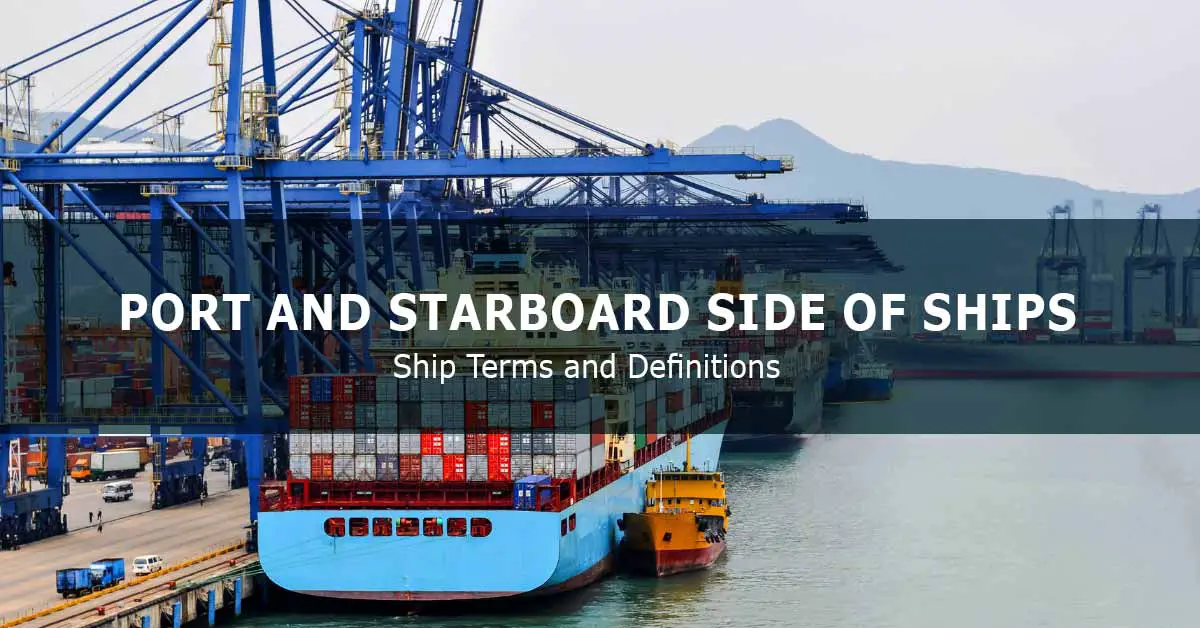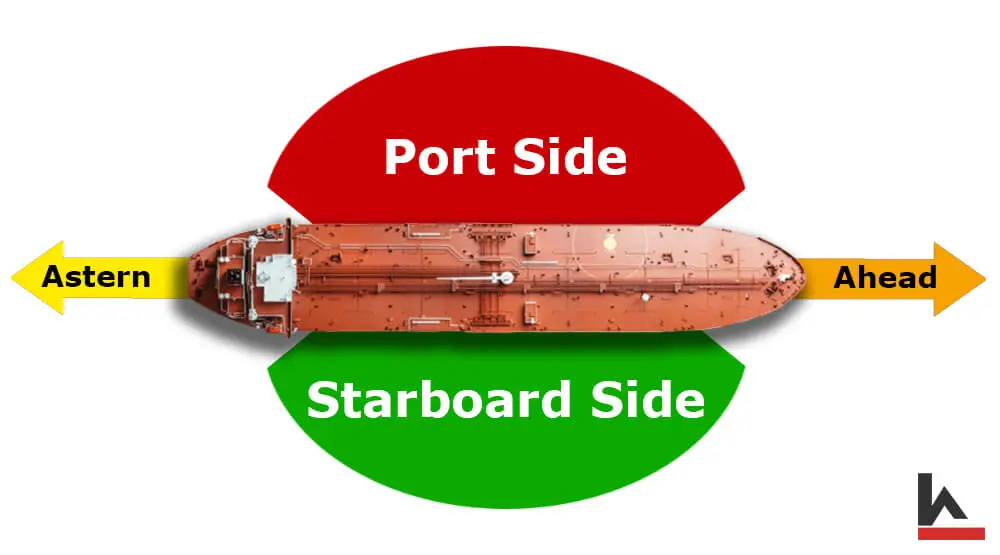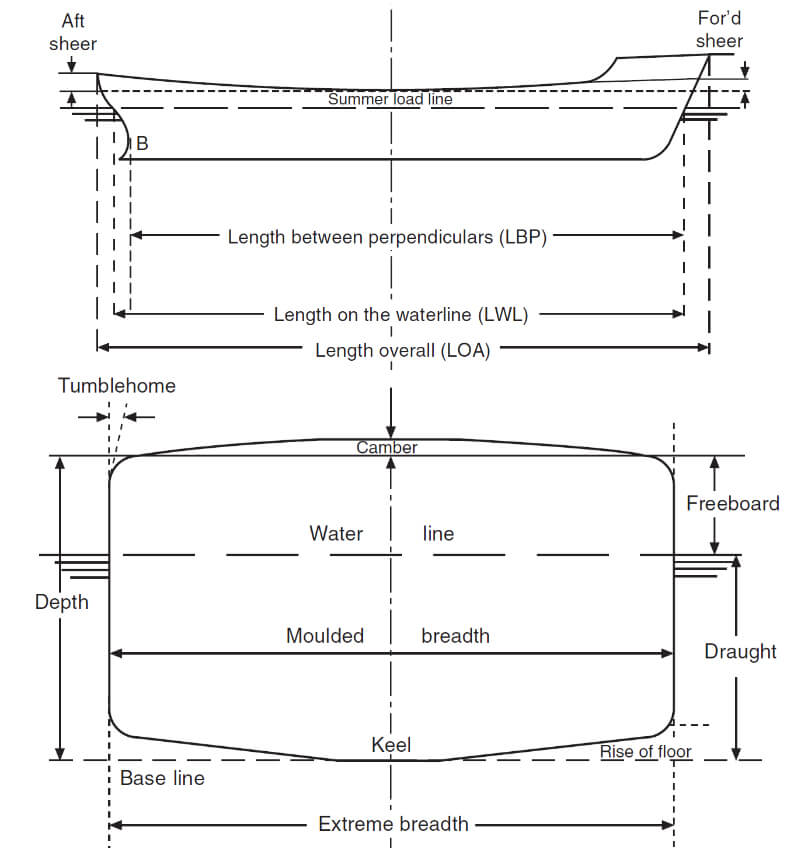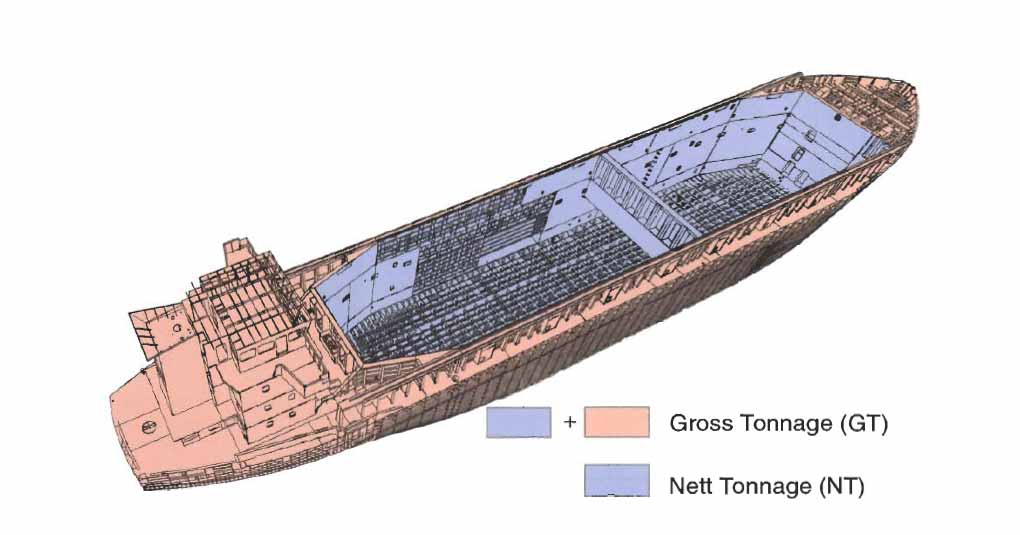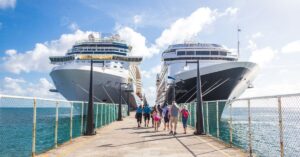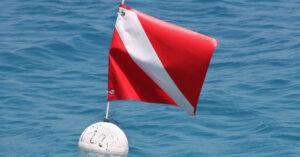As a seaman and mariner, you will likely see various portside and starboard side references during your studies or voyages. But what do all of these ship terms mean? Port and starboard are nautical terms of orientation that deal with the structure of ships.
This article will provide essential definitions for understanding these navigational terms and common terms you need to know about ship measurements. Get ready to learn about one of the core concepts of ship navigation.
What is the difference between the port & starboard side of a ship or boat?
Have you ever wondered what the difference is between a ship’s portside and starboard side? The port side is the left side of a ship when facing the bow or front of the vessel, while the starboard side is the right.
But why use these specific terms instead of just saying left or right? Well, it all goes back to the old days of sailing when sailors needed a universal language to communicate while aboard the ship or boat. Confusion was minimized using the terms port and starboard, and everyone knew which side was being referred to. This terminology has stuck with us even to this day and serves a vital purpose in the navigation and operations of any vessel on the water.
So briefly,
Portside refers to the left-hand side of a ship when facing the bow.
The starboard side refers to the right-hand side of a ship when facing the bow.
The history behind these two terms, port & starboard
In the past, steering ships were done with a steering oar at the right-hand side of the ship’s stern and rudders on their centerlines. The steering oars were at the right-hand side; as back then, the majority of the people were right-handed. Therefore, the right side of the ship was called “stéorbord,” the term stéorbord is a combination of two words, stéor (meaning ‘steer’) and bord (meaning ‘the side of a ship’), therefore, the term denoting the side on which the ship is steered. Which later was known as ‘steerboard’ or ‘starboard.’
Since the steering oar was on the ship’s right side, the port quay was on the left side to not interfere with steering oar operation. Hence, the left side of the vessel was called a portside. Previously, sailors have often used “larboard” instead of port; larboard term was used as the ship’s left side was the loading side. Larboard sounds similar to starboard, and sailors were easily confused between the two words, especially during rough sea conditions that made it difficult to hear. 1844, the Royal Navy ordered that port be used instead, and from there, the left side of a ship is called portside till today.
Interesting article: 13 Notable Ship Canals That You Should Know.
The importance of understanding the port and starboard side
To fully comprehend a vessel’s navigational terminology, understanding the portside and starboard side of the ship is crucial. Each term delivers a different direction and is significant in helping sailors navigate. The confusion between the two can cause potentially dangerous actions, and it could result in mishaps and accidents.
Several maritime regulations and conventions mandate that sailors to be well informed on such terminology as it is fundamental in maritime safety. Thus, gaining knowledge about the portside and starboard side of a ship’s operations can be extremely advantageous for those working on or around ships.
How to read a nautical chart using port and starboard points
Navigating the open sea can be a daunting task, but with the use of a nautical chart, it becomes much easier. Understanding how to read a chart is essential for any sailor or mariner. One crucial aspect is knowing the difference between a ship’s terms port and starboard side.
When reading a chart, the portside will generally be noted as the left side of the chart, while the starboard side is on the right. This can help a navigator pinpoint their location on the chart and ensure they are charting the correct course. Understanding these terms makes navigating the seas with a nautical chart more manageable.
Helpful tips on how to remember which side is which
A helpful tip for remembering which side is which is associating the word “port” with “left” because they both have four letters. Another trick is to keep in mind that “starboard” and “right” both have the letter “R” in them. By utilizing these simple memory aids, you can confidently identify a ship’s portside and starboard side.
Another helpful tip is associating the word “port” with the color red since both have four letters, and the port light on a ship is red. Similarly, associate “star” with the color green since the starboard of ships have green light. With a little practice and these helpful tricks, you’ll soon be able to easily differentiate between the portside and starboard side of a ship.
FAQ
How did they determine which side was port and starboard on ships?
Port and starboard are directions relative to the shape of a ship. When looking at the bow of a vessel, the port side is always located on the left and starboard on the right. This was done to help sailors identify which side they needed to be on when boarding or disembarking from the ship.
Why do they put portholes on the starboard side of a ship?
Portholes are small windows on a ship’s hull that provide illumination and ventilation to the vessel’s interior. They are typically located on the starboard side of a ship because it faces away from land, allowing passengers to look out onto the open sea.
Is larboard the side of a ship where lading is done, or is it the port where a ship is haboured?
No, the larboard is not the side of a ship where lading is done. Larboard refers to the left-hand side of a ship when facing forward and was traditionally used in nautical terms before the term “port” was widely adopted. The port is the harbor or dock where ships are moored, and lading (loading/unloading) is usually done there.
What are the four sides of a ship called?
The sides of a ship are commonly referred to as “port,” “starboard,” “forward,” and “aft.” “Port” is used for the left side when facing forward, while “starboard” is used for the right side. “Forward” indicates the direction towards the bow, while “aft” indicates the direction towards the stern.
Why do ships use the terms’ port’ and ‘starboard’ instead of ‘left’ or ‘right’?
The use of ‘port’ and ‘starboard’ instead of left and right to describe the sides of a ship serves an important purpose. Since navigating at sea can be disorienting, these two terms provide a more concrete reference point than left or right, which may change depending on how one is facing. This also helps when communicating directions on board a ship as it avoids any confusion due to language barriers.
What are the common ways to remember the port and starboard light colors?
One of the most common methods to remember the light colors for port and starboard is with the help of a phrase or mnemonic. A popular phrase used is “Red Right Returning,” which refers to the red colored light being on the right-hand side of a vessel when returning home. Another phrase often used is “Red On The Left When Leaving, ” reminding sailors that the red colored light should be on the left-hand side when leaving port.
Common terms and definitions you need to know about ship measurements
Breadth
The maximum beam of the vessel measured from the outside edge on either side of the vessel is the extreme breadth.
Moulded breadth
The beam of the vessel measured amidships between the inside edge on either side of the vessel.
Depth
The extreme distance of the ship is measured from the bottom side of the keel to the top of the deck beams.
Freeboard
The vertical distance, measured at the ship’s side, from the waterline to the top of the freeboard deck edge measured at the midships point.
Draught (Draft)
The vertical distance, measured at the ship’s side, from the waterline to the keel’s bottom side, measured at the midships point.
Draft (T fwd)
The vertical distance, measured at the ship’s side, from the waterline to the bottom side of the keel measured at the forward perpendicular (FP).
Draft (T aft)
The vertical distance, measured at the ship’s side, from the waterline to the bottom side of the keel measured at the AFT perpendicular (AP).
Perpendiculars
A perpendicular is an imaginary line drawn to the waterline from a point on the summer load line either forward (stem) of the ship’s Aft (rudder post or rudder stock).
Forward perpendicular (FP)
A perpendicular line drawn to the waterline at a point where the stem meets the summer waterline.
Aft perpendicular (AP)
A perpendicular line drawn to the waterline at a point where the after side of the rudder post or the centerline of the rudder stock (when rudder post is not fitted) meets the summer waterline.
Length between Perpendiculars (LBP)
The distance between the forward perpendicular (FP) and AFT perpendicular (AP).
Length Overall (LOA)
The maximum length of the vessel measured from the extreme forward point of the vessel to the extreme aft point.
Length on the waterline (LWL)
The distance between the stern and stem intersecting points with the waterline when the ship is on her summer load line.
Displacement
The displacement of a ship is the weight of water that the ship displaces; the weight is including the weight of the ship and all it contains. To calculate the ship’s displacement by multiplying the ship’s immersed volume in cubic meters to the density of the water, expressed in tones per cubic meter.
Tonnage
Ships constructed on or after 8 July 1982 are measured by their Tonnage Measurement according to the IMO 1969 International Conference. The tonnage of a vessel is divided into Gross Tonnage (GT) and Net Tonnage (NT).
Gross Tonnage (GT) is the measurement of the ship’s internal volume in cubic meters for the spaces below the main deck and enclosed spaces above the main deck.
Net Tonnage (NT) is the measurement intended to indicate the earning capacity of the vessel. The Net Tonnage is calculated from GT by subtracting the volume of space occupied by the crew, navigation and propulsion equipment, and workshops.
Load line marks (Plimsoll mark)
The international load line or Plimsoll line is the line that indicates the draft of the ship and the legal limit to which a ship may be loaded for specific water types and temperatures to maintain buoyancy safely. The purpose of a load line is to ensure that a ship has sufficient freeboard and thus sufficient reserve buoyancy. Commercial ships have a load line symbol permanently marked amidship to make it easy for anyone to determine if a ship has been overloaded.
Initially, the load line mark was a circle with a horizontal line to indicate the maximum draft. Over the years, additional marks have been added for different sea conditions and water densities.
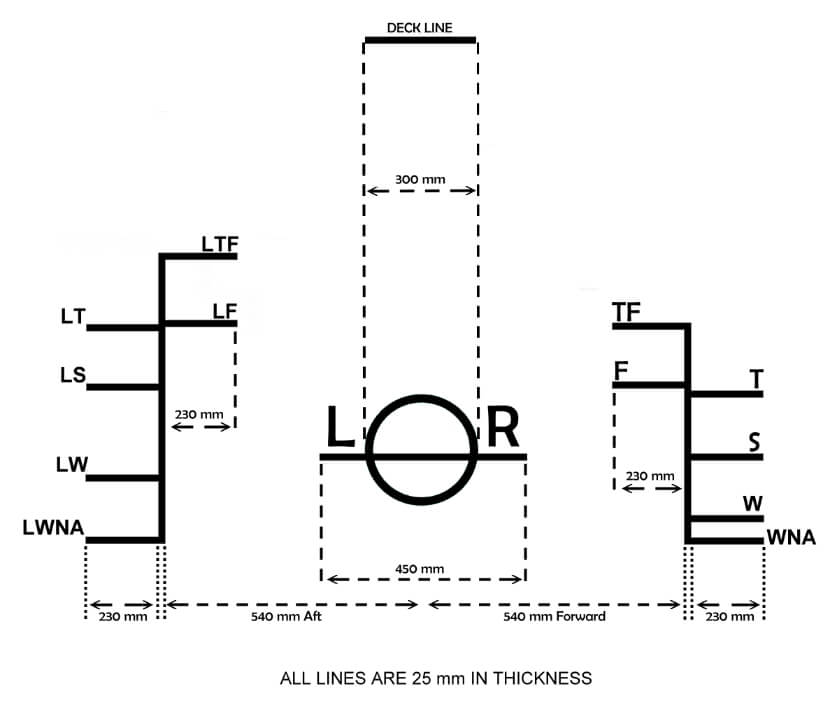
The two letters appear to the sides of the mark, indicating the classification society that surveys the vessel’s load line. The two initials are reflecting the specific classification society as follow:
- AB for the American Bureau of Shipping.
- LR for Lloyd’s Register.
- VL for DNV.
- BV for Bureau Veritas.
- NK for Nippon Kaiji Kyokai.
- RI for the Registro Italiano Navale (RINA).
- IR for the Indian Register of Shipping.
The letters on the load line marks have the following meanings:
- TF for tropical freshwater.
- F for freshwater.
- T for tropical seawater.
- S for summer temperate seawater.
- W for winter temperate seawater.
- WNA for winter North Atlantic.
The summer load line is the primary load line, and it is from this mark that all other marks are derived. The horizontal line through the circle of the Plimsoll mark is at the same level as the summer load line.
The winter load line is one forty-eighth of the summer load draft below the summer load line.
The tropical load line is one forty-eighth of the summer load draft above the summer load line.
The freshwater load line is at the same level as the tropical load line. The position of the tropical fresh load line relative to the tropical load line is found in the same way as the freshwater load line is to the summer load line.
Winter North Atlantic load line is used in some regions of the North Atlantic Ocean during the winter season.
Conclusion
Learning about common ship measurements and nautical terms is an important step for all sailors. Not only does it help you understand basic nautical chart reading, but it also ensures that you are always heading in the right direction. Remembering common terms such as depth, draft, freeboard, etc., will also help you speak Seaspeak.
If you have ever wondered what the difference between terms port and starboard and other ship definitions was, now you know! So, next time you find yourself aboard a ship, impress your friends with your knowledge of the ship’s common terms and definitions.
References:
- Wikipedia Encyclopedia.
- Seamanship Techniques, Third Edition, D.J. House.

